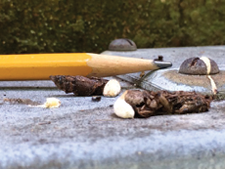
Lizard: ©Vitalii Hulai | AdobeStock
Editor’s Note: This article was reprinted with permission from Pinto & Associates.
During your inspections have you ever found what looks like rat droppings but with a strange white tip? Must be something they ate, you figured. But in reality, white-tipped fecal droppings (or scat) are characteristic of reptiles — both lizards and snakes — and of birds.
Lizards and snakes share something with birds that explains their unique droppings. Unlike mammals, who both urinate and defecate, lizards, snakes and birds have only one bodily excretory function and only one expelling orifice, the cloaca. Urine and poop are combined into one dropping. (There may be several droppings left by the animal, but each is a combination dropping.) Droppings are brown cords, several times longer than wide but usually with some white nitrogenous material incorporated. The white portion is crystallized uric acid. Droppings vary in size, depending on the size and species of the animal.
LIZARD SCAT. Most lizards feed on insects and spiders, but some also eat plants. Droppings range from mouse-size to large rat-size. As in rodents, an individual lizard dropping is pellet-like and may have rounded or tapered ends. The white cap-like end of each lizard dropping is fairly dry, rather firmly attached and makes up only a small portion of the entire dropping. In snakes and birds, the white or yellow portion of the dropping is larger and usually more liquid. Bird droppings contain a larger proportion of urea and so are whiter. In snakes, the brown cord portion is longer and convoluted.

SNAKE SCAT. Snakes are predators of insects, worms, slugs, amphibians, rodents, birds or birds’ eggs, depending on species. Snake droppings are looser and ropier than lizard droppings and may have undulations or no defined shape. The white urea portion may be in the form of a cap end or is more often seen as liquid white streaks along the brown cord portion. The consistency of snake scat is rather mushy and may contain bones, fur or feather from its prey.
Key Points to Remember: The scat or droppings of lizards and snakes usually contains a whitish/yellow portion that may be small and firm (lizards) or larger and more liquid (snakes). Lizard droppings could be confused with rodent or bat droppings, but the white cap end is the clue. Look at more than one dropping to be sure.
The authors are well-known industry consultants and co-owners of Pinto & Associates.

Explore the September 2019 Issue
Check out more from this issue and find your next story to read.